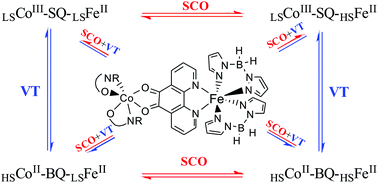Quantum chemical modeling of magnetically bistable metal coordination compounds. Synchronization of spin crossover, valence tautomerism and charge transfer induced spin transition mechanisms†
Abstract
It has been shown that the computationally designed bimetallic complexes formed as the adducts of CoII diketonates and salicylaldiminates with FeII chelates of 1,10-phenanthroline-5,6-dione are susceptible to the synchronized thermally induced intramolecular rearrangements between their electromeric forms LSCoIII-SQ-LSFeII, LSCoIII-SQ-HSFeII, HSCoII-BQ-LSFeII, HSCoII-BQ-HSFeII and also HSCoII-SQ-LSFeIII, which are governed by the spin-crossover (SCO), valence tautomerism (VT) and charge-transfer-induced spin transition (CTIST) mechanisms of spin-state switching. Stability of the adducts with respect to dissociation into components, relative energies and magnetic properties of the electromers and energy barriers against VT and unprecedented one-step (SCO + VT) rearrangements (estimated as minimum energy crossing points on the seams of the intersection of the corresponding potential energy surfaces) were calculated using the DFT (B3LYP*/6-311++G(d,p)) method. The calculations showed that all these characteristics of the system as well as the energy preferred spin-state switchable mechanisms are very sensitive to the structure of the cobalt diketonate (salicylaldiminate) fragment and can be varied and interchanged by the introduction of electron withdrawing substituents into the ligands.


 Please wait while we load your content...
Please wait while we load your content...